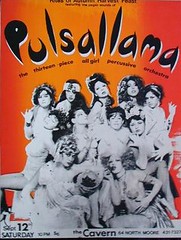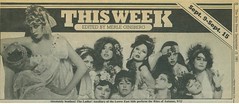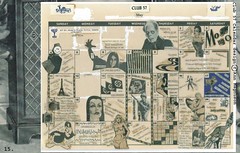Pat Ivers and Emily Armstrong continue sorting through their archives of punk-era concert footage as it’s digitized for the Downtown Collection at N.Y.U.’s Fales Library.
When the Go-Go’s arrived in New York City from the West Coast in August, 1980, they were a sweet, goofy package of pure pop in a New Wave wrapper. They provided the kind of light summer fun that can prove irresistible and were well received when they played their first night at Danceteria (see clip).
The reviews were a little harsher back in L.A. Wayzata Camerone, founder of Hollywood after-hours club the Zero Zero recalls, “They were laughed at; we thought they couldn’t play and they had insipid songs. But Belinda [Carlisle] was sweet and polite.”
The Go-Go’s had just recorded their first record for Stiff, “We Got the Beat,” and it was getting some radio play. The following year, IRS signed them and the band’s LP, “Beauty and the Beat,” was a smash. Those rough edges were sanded off and they were a viable commercial property, the first all-female band who wrote their own songs and played their own instruments to top the Billboard charts.
You’ve got to give them their props. As Ann Magnuson cannily observes, “Success was more characteristic of the West Coast, specifically in ‘This Town’ of Tinsel that The Go-Go’s famously sang about, not so much in the dystopia that was Downtown NY in the early 80s.” She should know. Ann was one of the few – along with Eric Bogosian – who made the transition from downtown performance artist to successful professional actor.
But back then, she was the founding member of Pulsallama. They were decidedly not the Go-Go’s. Described as “13 girls fighting over a cowbell,” they were an all-female percussion group – no guitars, just bass and anything they could bang on.
They emerged from the Ladies Auxillary at Club 57, the neo-Dada cabaret space on St Marks Place, and were a twisted Downtown version of the Junior League, throwing theme parties and events like the Stay Free Mini Prom and Ladies Wrestling. They even had a “Secret Boys File,” a kind of scouting report consisting of an actual box of index cards containing information about guys on the scene written by the girls who knew.
“Pulsallama was created specifically for the ‘Rites of Spring Bacchanal’ night at Club 57,” explains Magnuson. “We needed some pagan entertainment.” Min Sanchez remembers, “One night, we decided, why not have a band? Lots of people who can’t play have a band. Let’s do it!”
They started getting noticed. NY Rocker and the Soho Weekly News loved them. A reviewer for NME wrote, “I was dancing, screaming and laughing, all at the same time.” Magnuson described the band as “peddling in post primal racket and a delirious expression of our blithe and extremely contrarian spirits. I always envisioned it as a conceptual theater piece.”
But keeping 13 people on track with a concept is almost impossible, and Ann and some of the other girls left the band: “All bands are essentially dysfunctional families… and communism does not really work. For me, it was time to go,” she says.
The band dwindled to seven members but they pressed on. With Paul Dougherty, they made a video of their single, “The Devil Lives in My Husband’s Body.” A satirical take on an actual True Romance article, it created some controversy because of a reference to Tourette syndrome. But it wasn’t mean-spirited and received college radio play and even got into the early MTV rotation. They did some touring, even opened for the Clash. “Audience members were throwing beer and coins at us but by the second night, they were kind of rooting for us,” Sanchez remembers.
But when making their first real album, the record company ran out of money and wouldn’t release the masters. Things finally fell apart for good.
“We were a cult band,” Min recalls. “It was a collective, not a money thing. And we had fun. Isn’t that what it is all about?”






